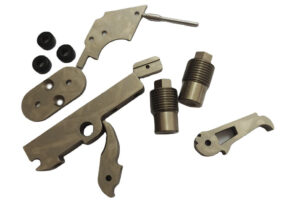Leading CNC Wire Cutting Manufacturer in China
Introduction
 In the realm of high-precision manufacturing, CNC wire cutting stands as a cornerstone technology for producing intricate, high-tolerance components. As a premier CNC Machining manufacturer in China, we specialize in delivering precision-engineered parts that meet the exacting demands of industries ranging from aerospace and automotive to medical devices and electronics. Leveraging advanced wire EDM (Electrical Discharge Machining) technology, stringent quality control, and decades of expertise, we empower global businesses with solutions that combine accuracy, speed, and cost efficiency.
In the realm of high-precision manufacturing, CNC wire cutting stands as a cornerstone technology for producing intricate, high-tolerance components. As a premier CNC Machining manufacturer in China, we specialize in delivering precision-engineered parts that meet the exacting demands of industries ranging from aerospace and automotive to medical devices and electronics. Leveraging advanced wire EDM (Electrical Discharge Machining) technology, stringent quality control, and decades of expertise, we empower global businesses with solutions that combine accuracy, speed, and cost efficiency.
Why Choose Our CNC Wire Cutting Services?
CNC wire cutting, or wire EDM, is a non-contact machining process that uses a thin, electrically charged wire to cut conductive materials with micron-level precision. Ideal for complex geometries and hard metals, this method ensures minimal material stress and exceptional surface finishes.
Key Advantages of Partnering with Us:
✅ Ultra-Precision Machining – Achieve tolerances as tight as ±0.002mm for parts requiring flawless dimensional accuracy.
✅ Wide Material Compatibility – Expertise in cutting tungsten, titanium, tool steel, aluminum, copper alloys, and exotic metals.
✅ Complex Geometries – Produce intricate shapes, sharp corners, and fine features impossible with traditional machining.
✅ No Heat-Affected Zones – Wire EDM eliminates thermal distortion, preserving material integrity.
✅ Scalable Solutions – From prototypes to high-volume production, we adapt seamlessly to your needs.
✅ ISO 9001:2015 & IATF 16949 Certified – Rigorous quality management ensures compliance with global standards.
Industries We Serve
Our CNC wire cutting expertise supports critical applications across diverse sectors:
1. Automotive & Electric Vehicles (EV)
- Precision gears and transmission components
- Stamping dies and molds
- Battery contacts and EV motor parts
2. Aerospace & Defense
- Turbine blades and engine components
- Lightweight structural frames
- Guidance system parts
3. Medical & Surgical Equipment
- Biocompatible implants (e.g., titanium bone plates)
- Micro-surgical tools and biopsy needles
- MRI and imaging device components
4. Electronics & Semiconductor
- Micro connectors and lead frames
- Wafer processing fixtures
- Heat sinks and shielding components
5. Industrial Tooling & Die-Making
- Injection molds and extrusion dies
- Punch tools and progressive dies
- Wear-resistant tooling inserts
Why Source CNC Wire Cutting from China?
China’s manufacturing ecosystem offers unparalleled advantages for businesses seeking high-quality, cost-effective wire EDM solutions:
✔ Cost Efficiency – Competitive pricing driven by advanced infrastructure and economies of scale.
✔ Cutting-Edge Technology – Our facilities utilize 5-axis CNC wire EDM machines and AGIE Charmilles systems for unmatched precision.
✔ Rapid Turnaround – Prototype lead times as short as 3-5 days with 24/7 production capabilities.
✔ Skilled Workforce – Engineers with 10+ years of experience in programming and optimizing wire EDM processes.
✔ Global Logistics – Seamless shipping to North America, Europe, and Asia via air, sea, or express freight.
Our CNC Wire Cutting Process
- Design & Programming – Convert CAD files into optimized machine toolpaths using AutoCAD and ESPRIT CAM software.
- Wire Selection – Choose brass, coated, or specialty wires based on material and finish requirements.
- Precision Cutting – Multi-pass cutting techniques achieve mirror-like surface finishes (up to Ra 0.1μm).
- Post-Processing – Deburring, heat treatment, or surface coatings (e.g., anodizing, plating) as needed.
- Quality Assurance – 100% inspection via CMM (Coordinate Measuring Machines) and optical comparators.
Commitment to Quality & Sustainability
Quality is the bedrock of our operations. Our ISO-certified processes include:
- Material Traceability – Certifications for all raw materials.
- In-Process Inspections – Real-time monitoring to prevent deviations.
- Final Approval – Compliance with client drawings and international standards (e.g., ASTM, DIN).
We also prioritize sustainability through:
♻ Material Recycling – Reprocessing metal scraps for reuse.
♻ Energy-Efficient Machines – Reducing power consumption without compromising output.
♻ Waste Minimization – Advanced nesting software optimizes material usage.
Partner with a Trusted CNC Wire Cutting Manufacturer in China
Whether you’re developing cutting-edge aerospace components or high-volume automotive tooling, our expertise ensures precision, reliability, and cost savings. We offer:
📌 Free DFM (Design for Manufacturing) Analysis – Optimize your design for efficiency and cost.
📌 Transparent Pricing – No hidden fees, with detailed quotes upfront.
📌 Dedicated Support – 24/7 communication and real-time project tracking.
Contact Us Today!
Elevate your manufacturing capabilities with a CNC wire cutting manufacturer in China that combines technology, skill, and customer-centric values. Request a free quote and experience the difference of working with a leader in precision wire EDM.






